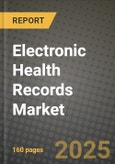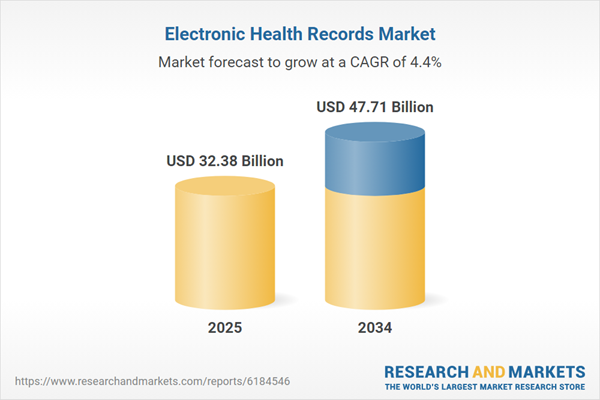Electronic Health Records Market
The Electronic Health Records Market comprises software platforms, cloud services, interoperability APIs, analytics, and implementation/O&M services that digitize patient information and orchestrate clinical, financial, and operational workflows across hospitals, ambulatory practices, diagnostics, and virtual care. Top applications include clinician documentation, CPOE/e-prescribing, results and imaging management, medication administration (eMAR/BCMA), clinical decision support, revenue cycle, patient engagement portals, and population health. Recent trends emphasize cloud-first deployments, FHIR-native interoperability, API marketplaces, ambient/AI-powered documentation, and integrated virtual care spanning telehealth, remote patient monitoring, and home-based services. Drivers include regulatory incentives/penalties, safety and quality mandates, workforce productivity pressures, cybersecurity resilience, and payer-provider data-sharing for value-based care. Competitive dynamics feature global platform vendors, regional HIS specialists, best-of-breed modules (oncology, periop, behavioral), and rapidly maturing add-ons in AI scribing, coding, prior auth automation, and risk adjustment. Consolidation among health systems favors enterprise platforms, while mid-market and ambulatory segments adopt modular, cloud EHRs with rapid go-live playbooks. Barriers remain: clinician burnout linked to documentation burden, interoperability gaps with legacy systems, change management costs, and data governance across multi-entity networks. Vendor selection hinges on total cost of ownership, clinical usability, integration depth, uptime/SLA, security certifications, and roadmap transparency. Overall, EHRs are evolving from digital filing cabinets to intelligent operating systems for care delivery - embedding AI, real-time insights, and closed-loop workflows that connect point of care to revenue integrity and population health outcomes.Electronic Health Records Market Key Insights
- Cloud-first and managed services
- FHIR-native interoperability becomes table stakes
- Ambient and generative AI for documentation relief
- Integrated virtual and home-based care
- Usability and workflow redesign over features
- Revenue integrity and automation
- Data liquidity for value-based care
- Cybersecurity and resilience
- Extensibility via marketplaces and microapps
- Data governance and equity
Electronic Health Records Market Reginal Analysis
North America
Mature adoption with ongoing consolidation drives enterprise EHR standardization and large-scale cloud migrations. Emphasis is on ambient AI, revenue cycle optimization, and payer-provider interoperability for value-based arrangements. Cyber resilience and downtime readiness are procurement priorities, while independent practices seek affordable, specialty-tuned cloud EHRs with turnkey implementation.Europe
National and regional digitization strategies promote interoperable, privacy-forward EHRs and cross-border data exchange. Public tenders favor open standards, localization, and strong information security. Hospital modernizations pair core EHR rollouts with ePrescription, eReferral, and patient access apps; data governance and multilingual usability shape vendor scoring.Asia-Pacific
Rapid hospital build-outs and private network growth fuel greenfield EHR deployments, often cloud-first with mobile-centric clinician tools. Mixed regulatory landscapes require flexible localization, while telehealth integration and medical device connectivity are high priorities. Training, change management, and scalable pricing models determine success across diverse provider sizes.Middle East & Africa
Flagship health cities and public modernization programs adopt enterprise platforms with robust analytics and revenue cycle. Interoperability frameworks and national ID initiatives support longitudinal records. Remote and emerging markets prioritize modular cloud EHRs, localization, and offline-capable workflows to overcome bandwidth and workforce constraints.South & Central America
Public-private collaborations drive digitization with affordability, localization, and compliance at the forefront. Cloud deployments with phased rollouts are common; telehealth and patient portals extend reach in underserved areas. Vendors that bundle implementation services, training, and financial flexibility gain traction amid budget variability and heterogeneous infrastructure.Electronic Health Records Market Segmentation
By Technology
- Client Server-based EHR
- Web-based EHR
By Application
- Acute
- Ambulatory Care Centers
- Post Acute
By End-Use
- Hospital Use
- Ambulatory Use
By Product
- Licensed Software
- Technology Resale
- Subscriptions
- Professional Services
- Others
Key Market players
Epic Systems, Oracle Health (Cerner), MEDITECH, Altera Digital Health, athenahealth, eClinicalWorks, NextGen Healthcare, Greenway Health, CPSI (Evident/TruBridge), MEDHOST, InterSystems (TrakCare), Dedalus Group, EMIS Group, TPP (The Phoenix Partnership), Modernizing Medicine (ModMed)Electronic Health Records Market Analytics
The report employs rigorous tools, including Porter’s Five Forces, value chain mapping, and scenario-based modelling, to assess supply-demand dynamics. Cross-sector influences from parent, derived, and substitute markets are evaluated to identify risks and opportunities. Trade and pricing analytics provide an up-to-date view of international flows, including leading exporters, importers, and regional price trends.Macroeconomic indicators, policy frameworks such as carbon pricing and energy security strategies, and evolving consumer behaviour are considered in forecasting scenarios. Recent deal flows, partnerships, and technology innovations are incorporated to assess their impact on future market performance.
Electronic Health Records Market Competitive Intelligence
The competitive landscape is mapped through proprietary frameworks, profiling leading companies with details on business models, product portfolios, financial performance, and strategic initiatives. Key developments such as mergers & acquisitions, technology collaborations, investment inflows, and regional expansions are analyzed for their competitive impact. The report also identifies emerging players and innovative startups contributing to market disruption.Regional insights highlight the most promising investment destinations, regulatory landscapes, and evolving partnerships across energy and industrial corridors.
Countries Covered
- North America - Electronic Health Records market data and outlook to 2034
- United States
- Canada
- Mexico
- Europe - Electronic Health Records market data and outlook to 2034
- Germany
- United Kingdom
- France
- Italy
- Spain
- BeNeLux
- Russia
- Sweden
- Asia-Pacific - Electronic Health Records market data and outlook to 2034
- China
- Japan
- India
- South Korea
- Australia
- Indonesia
- Malaysia
- Vietnam
- Middle East and Africa - Electronic Health Records market data and outlook to 2034
- Saudi Arabia
- South Africa
- Iran
- UAE
- Egypt
- South and Central America - Electronic Health Records market data and outlook to 2034
- Brazil
- Argentina
- Chile
- Peru
Research Methodology
This study combines primary inputs from industry experts across the Electronic Health Records value chain with secondary data from associations, government publications, trade databases, and company disclosures. Proprietary modeling techniques, including data triangulation, statistical correlation, and scenario planning, are applied to deliver reliable market sizing and forecasting.Key Questions Addressed
- What is the current and forecast market size of the Electronic Health Records industry at global, regional, and country levels?
- Which types, applications, and technologies present the highest growth potential?
- How are supply chains adapting to geopolitical and economic shocks?
- What role do policy frameworks, trade flows, and sustainability targets play in shaping demand?
- Who are the leading players, and how are their strategies evolving in the face of global uncertainty?
- Which regional “hotspots” and customer segments will outpace the market, and what go-to-market and partnership models best support entry and expansion?
- Where are the most investable opportunities - across technology roadmaps, sustainability-linked innovation, and M&A - and what is the best segment to invest over the next 3-5 years?
Your Key Takeaways from the Electronic Health Records Market Report
- Global Electronic Health Records market size and growth projections (CAGR), 2024-2034
- Impact of Russia-Ukraine, Israel-Palestine, and Hamas conflicts on Electronic Health Records trade, costs, and supply chains
- Electronic Health Records market size, share, and outlook across 5 regions and 27 countries, 2023-2034
- Electronic Health Records market size, CAGR, and market share of key products, applications, and end-user verticals, 2023-2034
- Short- and long-term Electronic Health Records market trends, drivers, restraints, and opportunities
- Porter’s Five Forces analysis, technological developments, and Electronic Health Records supply chain analysis
- Electronic Health Records trade analysis, Electronic Health Records market price analysis, and Electronic Health Records supply/demand dynamics
- Profiles of 5 leading companies - overview, key strategies, financials, and products
- Latest Electronic Health Records market news and developments
Additional Support
With the purchase of this report, you will receive:- An updated PDF report and an MS Excel data workbook containing all market tables and figures for easy analysis.
- 7-day post-sale analyst support for clarifications and in-scope supplementary data, ensuring the deliverable aligns precisely with your requirements.
- Complimentary report update to incorporate the latest available data and the impact of recent market developments.
This product will be delivered within 1-3 business days.
Table of Contents
Companies Mentioned
- Epic Systems
- Oracle Health (Cerner)
- MEDITECH
- Altera Digital Health
- athenahealth
- eClinicalWorks
- NextGen Healthcare
- Greenway Health
- CPSI (Evident/TruBridge)
- MEDHOST
- InterSystems (TrakCare)
- Dedalus Group
- EMIS Group
- TPP (The Phoenix Partnership)
- Modernizing Medicine (ModMed)
Table Information
| Report Attribute | Details |
|---|---|
| No. of Pages | 160 |
| Published | November 2025 |
| Forecast Period | 2025 - 2034 |
| Estimated Market Value ( USD | $ 32.38 Billion |
| Forecasted Market Value ( USD | $ 47.71 Billion |
| Compound Annual Growth Rate | 4.4% |
| Regions Covered | Global |
| No. of Companies Mentioned | 15 |









